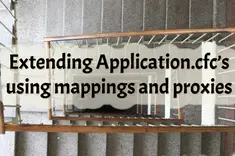Posts made on January 2021

Extending Application.cfcs Using Mappings and Proxies
How to use multiple Application.cfc’s in a ColdFusion application and extend them using mappings and proxies.

Happy New Year!
I hope that everyone has a wonderful New Year and I wanted to provide a status update on Galaxie Blog. While I have not b
